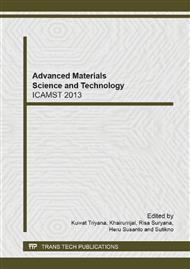[1]
K.S. Novoselov, A.K. Geim, S.V. Morozov, D. Jiang, Y. Zhang, S.V. Dubonos, I.V. Grigorieva, A.A. Firsov, Electric field effect in atomically thin carbon films, Science 306 (2004) 666-669.
DOI: 10.1126/science.1102896
Google Scholar
[2]
D. Jena, T. Fang, Q. Zhang, H. Xing, Zener tunneling in semiconducting nanotube and graphene nanoribbon p−n junctions, Appl. Phys. Lett. 93 (2008) 112106-1-112106-3.
DOI: 10.1063/1.2983744
Google Scholar
[3]
W. Yansen, M. Abdullah, Khairurrijal, Application of Airy function approach to model electron tunneling in graphene nanoribbon-based P-N junction diodes, Jurnal Nanosains & Nanoteknologi 3 (2010) 18–21.
Google Scholar
[4]
H. Raza, E.C. Kan, Armchair graphene nanoribbons: Electronic structure and electric field modulation, Phys. Rev. B 77 (2008) 245434-1-245434-5.
DOI: 10.1103/physrevb.77.245434
Google Scholar
[5]
J. Fernandez-Rossier, J.J. Palacios, L. Brey, Electronic structure of gated graphene and graphene ribbons, Phys. Rev. B 75 (2007) 205441-1-205441-8.
DOI: 10.1103/physrevb.75.205441
Google Scholar
[6]
N.M.R. Peres, A.H. Castro Neto, F. Guinea, Conductance quantization in mesoscopic graphene, Phys. Rev. B 73 (2006) 195411-1-195411-8.
DOI: 10.1103/physrevb.73.239902
Google Scholar
[7]
F. Munoz-Rojas, D. Jacob, J. Fernandez-Rossier, J.J. Palacios, Coherent transport in graphene nanoconstrictions, Phys. Rev. B 74 (2006) 195417-1-195417-8.
DOI: 10.1103/physrevb.74.195417
Google Scholar
[8]
L. Brey, H.A. Fertig, Electronic states of graphene nanoribbons, Phys. Rev. B 73 (2006) 235411-1-235411-5.
Google Scholar
[9]
Y.W. Son, M.L. Cohen, S.G. Louie, Energy gaps in graphene nanoribbons, Phys. Rev. Lett. 97 (2006) 216803-1-216803-4.
DOI: 10.1103/physrevlett.98.089901
Google Scholar
[10]
Q. Yan, B. Huang, J. Yu, F. Zheng, J. Zhang, J. Wu, B.L. Gu, F. Liu, W. Duan, Intrinsic current-voltage characteristics of graphene nanoribbon transistors and effect of edge doping, Nano Lett. 7 (2007) 1469–1473.
DOI: 10.1021/nl070133j
Google Scholar
[11]
X. Liang, Z. Fu, S.Y. Chou, Graphene transistors fabricated via transfer-printing in device active-areas on large wafer, Nano Lett. 7 (2007) 3840–3844.
DOI: 10.1021/nl072566s
Google Scholar
[12]
I. Meric, M.Y. Han, A.F. Young, B. Ozyilmaz, P. Kim, K.L. Shepard, Current saturation in zero-bandgap, top-gated graphene field-effect transistors, Nat. Nanotechnol. 3 (2008) 654-659.
DOI: 10.1038/nnano.2008.268
Google Scholar
[13]
X. Wu, M. Sprinkle, X. Li, F. Ming, C. Berger, W.A. de Heer, The epitaxial-graphene/graphene-oxide junction, an essential step towards epitaxial graphene electronics, Phys. Rev. Lett. 101 (2008) 026801-1-02681-4.
DOI: 10.1103/physrevlett.101.026801
Google Scholar
[14]
B. Oyilmaz, P. Jarillo-Herrero, D. Efetov, D.A. Abanin, L.S., Levitov, P. Kim, Electronic transport and quantum Hall effect in bipolar graphene p-n-p junctions, Phys. Rev. Lett. 99 (2007) 166804-1-166804-4.
DOI: 10.1103/physrevlett.99.166804
Google Scholar
[15]
F. Schwierz, Graphene transistor, Nat. Nanotechnol. 5 (2010) 487–496.
Google Scholar
[16]
D. Jimenez, A current-voltage model for Schottky-barriergraphene based transistors, Nanotechnology, 19 (2008) 345204-1-345204-4.
DOI: 10.1088/0957-4484/19/34/345204
Google Scholar
[17]
A. Kargar, Analytical modeling of current in graphene nanoribbon field effect transistors, IEEE-NANO 2009, 9th IEEE Conference on Nanotechnology (2009) 710–712.
Google Scholar
[18]
W.Z. Shangguan, X. Zhou, S.B. Chiah, G.H. See, K. Chandrasekaran, Compact gate-current model based on transfer-matrix method, J. Appl. Phys. 97 (2005) 123709-1-123709-4.
DOI: 10.1063/1.1929885
Google Scholar
[19]
E. Suhendi, R. Syariati, F.A. Noor, N. Kurniasih, Khairurrijal, Model of a Tunneling Current in a p-n Junction Based on Armchair Graphene Nanoribbons – an Airy Function Approach and a Transfer Matrix Method, submitted to American Institute of Physics (AIP) Conference Proceedings (2013).
DOI: 10.1063/1.4868757
Google Scholar



